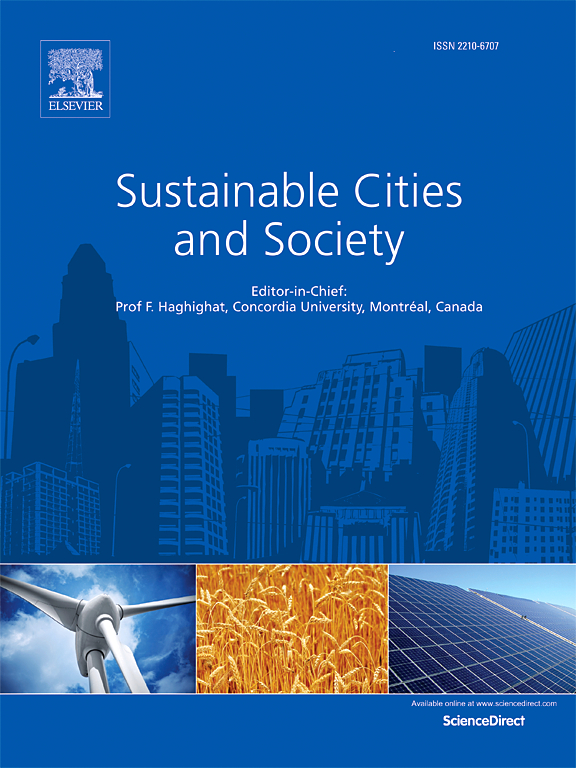基于地表温度控制的绿地优化配置——以岩溶山地城市为例
IF 10.5
1区 工程技术
Q1 CONSTRUCTION & BUILDING TECHNOLOGY
引用次数: 0
摘要
尽管越来越多的人认识到绿地在缓解城市热岛效应方面的作用,但关于不同绿地景观模式如何影响不同空间尺度的地表温度(LST)的研究仍然有限,特别是在山地城市,人地冲突使这种关系复杂化。利用XGBoost-SHAP模型,在150 ~ 600 m格网尺度上,分析了贵阳市中心城区主要灰绿景观组合(人工绿地-不透水面组合(AGIS)、山地绿地-不透水面组合(MGIS)、人工绿地-山地绿地-不透水面组合(AGMGIS))中不同绿地景观格局对地表温度的影响。结果表明:(1)在不同的空间尺度上,MGIS的平均地表温度最低,而AGIS的平均地表温度最高,说明山地绿地的降温效果优于人工绿地。(2)在增加绿地面积的同时,斑块连通性的增强进一步降低了山地城市的地表温度。(3)绿地景观格局对地表温度显著降温阈值的影响呈现尺度依赖效应。例如,在150 ~ 600 m网格尺度上,MGIS山地绿地比例的降温阈值为70.93% ~ 86.27%。山地绿地景观百分比高、最大斑块指数大、景观划分指数低,显著增强了MGIS和AGMGIS的降温效果。(4)增加斑块形状的复杂性可以改善小型山地绿地的降温效果,而增加连通性可以改善小型人工绿地的降温效果。总的来说,在山地城市中,最大化山区绿地的面积和完整性对于实现最佳降温至关重要。当山地绿地面积受限时,建议保持斑块形状的复杂性。同时,在人工绿地面积有限的情况下,保证斑块的连通性至关重要。这些战略增强了降温效果,并为减轻山区城市地区的热岛问题提供了见解。本文章由计算机程序翻译,如有差异,请以英文原文为准。

Optimizing green space configuration for mitigating land surface temperature: A case study of karst mountainous cities
Despite growing recognition of green spaces' role in mitigating urban heat island (UHI) effects, research on how different green space landscape patterns impact land surface temperature (LST) across various spatial scales remains limited, particularly in mountainous cities where human-land conflicts complicate this relationship. This study uses XGBoost-SHAP models to analyze the effects of different green space landscape patterns on LST in major gray-green landscape combinations (artificial green space-impervious surface combination (AGIS), mountain green space-impervious surface combination (MGIS), artificial green space-mountain green space-impervious surface combination (AGMGIS)) in the central urban area of Guiyang City, China, across grid scales of 150 to 600 m. The results show that: (1) At various spatial scales, the MGIS exhibits the lowest average LST, whereas AGIS registers the highest, underscoring the superior cooling efficacy of mountain green spaces over their artificial counterparts. (2) Beyond increasing green space area, enhancing patch connectivity further reduces the LST in mountainous cities. (3) The influence of green space landscape patterns on LST's significant cooling thresholds exhibits a scale-dependent effect. For instance, the cooling thresholds for MGIS's mountain green space proportion range from 70.93 % to 86.27 % across grid scales of 150 to 600 m. Notably, high landscape percentage, large largest patch index, and low landscape division index in mountain green spaces significantly enhance cooling effects of both MGIS and AGMGIS. (4) Increasing patch shape complexity improves cooling in small mountain green spaces, while enhancing connectivity boosts cooling in small artificial green spaces. Overall, in mountainous cities, maximizing the area and integrity of mountain green spaces is essential for optimal cooling. When mountain green space area is constrained, maintaining patch shape complexity is recommended. Meanwhile, when artificial green space area is limited, ensuring patch connectivity is crucial. These strategies enhance cooling effects and provide insights for mitigating UHI in mountainous urban areas.
求助全文
通过发布文献求助,成功后即可免费获取论文全文。
去求助
来源期刊

Sustainable Cities and Society
Social Sciences-Geography, Planning and Development
CiteScore
22.00
自引率
13.70%
发文量
810
审稿时长
27 days
期刊介绍:
Sustainable Cities and Society (SCS) is an international journal that focuses on fundamental and applied research to promote environmentally sustainable and socially resilient cities. The journal welcomes cross-cutting, multi-disciplinary research in various areas, including:
1. Smart cities and resilient environments;
2. Alternative/clean energy sources, energy distribution, distributed energy generation, and energy demand reduction/management;
3. Monitoring and improving air quality in built environment and cities (e.g., healthy built environment and air quality management);
4. Energy efficient, low/zero carbon, and green buildings/communities;
5. Climate change mitigation and adaptation in urban environments;
6. Green infrastructure and BMPs;
7. Environmental Footprint accounting and management;
8. Urban agriculture and forestry;
9. ICT, smart grid and intelligent infrastructure;
10. Urban design/planning, regulations, legislation, certification, economics, and policy;
11. Social aspects, impacts and resiliency of cities;
12. Behavior monitoring, analysis and change within urban communities;
13. Health monitoring and improvement;
14. Nexus issues related to sustainable cities and societies;
15. Smart city governance;
16. Decision Support Systems for trade-off and uncertainty analysis for improved management of cities and society;
17. Big data, machine learning, and artificial intelligence applications and case studies;
18. Critical infrastructure protection, including security, privacy, forensics, and reliability issues of cyber-physical systems.
19. Water footprint reduction and urban water distribution, harvesting, treatment, reuse and management;
20. Waste reduction and recycling;
21. Wastewater collection, treatment and recycling;
22. Smart, clean and healthy transportation systems and infrastructure;
 求助内容:
求助内容: 应助结果提醒方式:
应助结果提醒方式:


